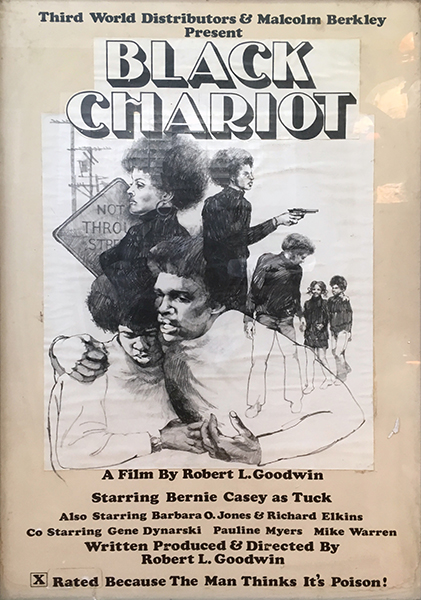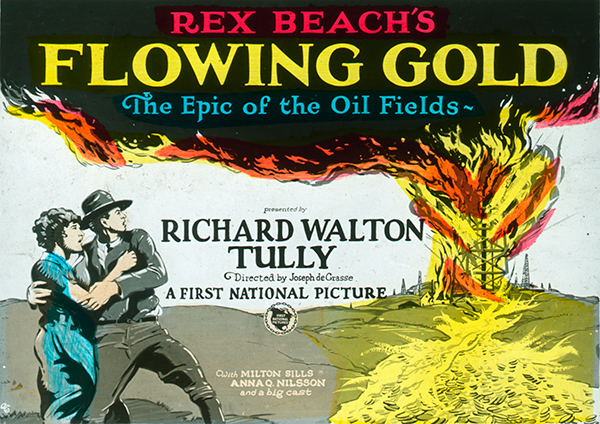- Films Preserved Through the NFPF
- 2014 Federal Grant Winners
- 2015 Federal Grant Winners
- 2016 Federal Grant Winners
- 2017 Federal Grant Winners
- 2018 Federal Grant Winners
- 2019 Federal Grant Winners
- 2020 Federal Grant Winners
- 2021 Federal Grant Winners
- 2022 Federal Grant Winners
- 2023 Federal Grant Winners
- 2024 Federal Grant Winners
- 2025 Federal Grant Winners
2020 Federal Grant Winners
 |
|
The City of Dreams (1983) will be preserved by the Chicago Film Society with NFPF support.
|
-
Arizona and New Mexico (ca. 1948–50), nature film of flora and fauna in the great cactus belt by naturalist Paul G. Howes (Bruce Museum). Black Chariot (1971) will be preserved by the National Museum of African American History and Culture, Smithsonian Institution with NFPF support. (Courtesy Robert F. Goodwin Estate; photo by Rhea Combs)
Black Chariot (1971) will be preserved by the National Museum of African American History and Culture, Smithsonian Institution with NFPF support. (Courtesy Robert F. Goodwin Estate; photo by Rhea Combs) - Bath Iron Works Collection (ca. 1937–56), documentation of ship-launchings at the important national shipyard, including the 1937 America’s Cup winner Ranger (Maine Maritime Museum).
- Beauty and the Beast (ca. 1973), JoAnn Elam’s experimental melding of shadow puppets and scenes of farm and home life (Chicago Film Archives).
- The Biggest Show on Earth Thrills the Coolidges (1928), footage of John Ringling hosting President Coolidge and his wife at the Ringling Bros. and Barnum & Bailey circus (John and Mable Ringling Museum of Art).
- Bird Islands of Peru (1930), documentation of the Brooklyn Museum expedition to study the guano-producing fowl of the Islands of Santa Rosa and Lobos de Afuera, led by Robert Cushman Murphy (American Museum of Natural History).
- Black Chariot (1971), once-lost dramatic feature on the Black liberation struggle, directed by Robert L. Goodwin and starring Bernie Casey (National Museum of African American History and Culture, Smithsonian Institution).
- Cabbage (1972), Dorothy Wiley’s experimental depiction of food preparation (Pacific Film Archive).
- Childcare: People’s Liberation (1970), documentary on the need for cooperative childcare, directed by Bonnie Friedman and Karen Mitnik of the Newsreel Collective (New York Public Library).
- Chocolate Cake (ca. 1973), caustic vignette on domesticity and sexism by JoAnn Elam (Chicago Film Archives).
- The City of Dreams (1983), 70mm cityscape made for the “Here’s Chicago” exhibit at the town’s Water Tower Pumping Station (Chicago Film Society).
- Clarence McMillin Collection (1930–48), home movies of the Pribilof Islands of Alaska, filmed by a U.S. government agent sent to manage its Aleut population (University of Alaska Fairbanks).
- Coffee (1977), silent, meditative film of an everyday object by Dorothy Wiley (Pacific Film Archive).
- Dance and Human History (1974), assemblage of ethnographic dance footage, narrated and co-directed by Alan Lomax (Association for Cultural Equity).
- David E. Finley Collection (1928–33), home movies by the first director of the National Gallery of Art (National Gallery of Art).
- Egyptian and Hungarian Refugees (1957), documentation of Jewish emigration from post–Suez Crisis Egypt in 1957 and post-revolution Hungary in 1956 (American Jewish Joint Distribution Committee).
- Ernest Allison Collection (ca. 1929–35), home movies from China by an American aviator working for the China National Aviation Corporation (Pan Am Historical Foundation).
- Ernest N. “Dutch” Morial Campaign Films (1977), sponsored films from the 1977 mayoral campaign of the first African American mayor of New Orleans (Amistad Research Center).
-
Flowing Gold (1924), silent melodrama on the early days of the Texas oil boom, directed by Joseph de Grasse and starring Milton Sills and Anna Q. Nilsson (San Francisco Silent Film Festival). Flowing Gold (1924) will be preserved by the San Francisco Silent Film Festival with NFPF support.
Flowing Gold (1924) will be preserved by the San Francisco Silent Film Festival with NFPF support. - GRASS (1997), single-shot experimental “microcinema” film by Naomi Uman (XFR Collective).
- Green Paradise: The Story of a Camping Trip (1931), earliest known moving images of the Bob Marshall Wilderness Complex in western Montana, filmed in Kodacolor (Montana Historical Society).
- Hey Mama (1967), cinema-verité documentary on working-class African American life in the Oakwood neighborhood of Venice, California (UCLA Film & Television Archive).
- His Last Race (1923), silent feature starring daredevil rider Rex “Snowy” Baker and his wonderhorse Boomerang, directed by B. Reeves Eason (George Eastman Museum).
- Israel Field Trip (1949–51), footage of Jewish refugees arriving and being settled in Israel, filmed by the JDC’s Executive Vice Chairman (American Jewish Joint Distribution Committee).
- Jeremelu (1964), Naomi Levine’s experimental exercise in editing, featuring Gerard Malanga and Jack Smith (Anthology Film Archives).
- Letters (1972), abstract series of multi-dimensional letters created and filmed by Dorothy Wiley (Pacific Film Archive).
- Lie Back and Enjoy It (1982), JoAnn Elam’s dialectical examination of the politics of representation and the power imbalance between male filmmakers and female subjects (Chicago Film Archives).
- Love of 3 Oranges (1993), Naomi Uman’s multi-media depiction of femininity in operetta form (XFR Collective).
- Luther Cressman Field Work Films (1930s–50s), documentation of the influential archaeologist’s excavations on the Great Basin, Columbia River, and former Klamath Reservation (University of Oregon).
- The Maid of McMillan (1916), possibly the earliest extant student film, filmed on campus and in St. Louis (Washington University in St. Louis).
- Payroll Pirates (1920), western starring Helen Gibson, the pioneering action star of The Hazards of Helen (George Eastman Museum).
- Play Championship Basketball (1946), “coach’s aid” instructional series featuring two-time Olympic gold winning coach Henry Iba (Oklahoma State University).
- Rainbow Bridge Monument Valley Expedition Collection (1930s), documentation of the first interdisciplinary expeditions in the Southwest, organized by Ansel Hall in the Four Corners region (Fort Lewis College).
- Relics of the Connecticut Indians (ca. late 1950s–early 1960s), documentary on regional native sites and artifacts by Paul G. Howes (Bruce Museum).
- Richard I. Miller Collection (1933–36), home movies by a steamboat agent of life in remote Mitkof island, off southeastern Alaska (Alaska Moving Image Preservation Association).
- Robert Frost at Agnes Scott College (1960), footage of the poet’s annual off-the-cuff lecture on literature (Agnes Scott College).
- Robert Garfias American Music Film Collection (1968–70), eminent ethnomusicologist’s performance footage of blues legends Son House and John Lee Hooker (University of Washington).
- Rotoscope Demonstration Reels (ca. 1960s), Missouri-set demonstration reels of a widescreen projection system designed to surpass Cinerama, invented by Rowe Carney and Tom Smith (State Historical Society of Missouri).
- Russia (1971) observational documentary on the Soviet Union by Theodore Holcomb, with narration by journalist Harrison Salisbury (University of California, Santa Barbara).
- Ted Serios “Thoughtography” Research Films (ca. 1960s), documentation of paranormal psychologist Jule Eisenbud’s research on psychic Ted Serios and his purported ability to record thoughts on photographs (University of Maryland, Baltimore County).
- 3 Goats and a Gruff (1960s), JoAnn Elam’s revision of the children’s fable through the lens of youth culture and revolutionary politics (Chicago Film Archives).
- Tony Williams in Africa (1973), documentary of the fusion jazz drummer’s experience with the West African talking drum, directed by Yale professor and jazz musician Willie Ruff (Yale Film Study Center).
- Travel Films of George L.K. Morris (1934), home movies of the abstract painter’s travels through China and India (Frelinghuysen Morris House & Studio).
- Walter Barth Collection (1927–37), home movies of a German engineer’s life before and after his immigration to the US in 1931 (Knox County Public Library).
- The Weeny Worm or the Fat Inkeeper (1972), Dorothy Wiley’s experimental film of spoon worm studies at the UC Davis Bodega Bay Marine Laboratory (Pacific Film Archive).
- When Betty Bets (1917), only extant film of Broadway actress and singer Marie Cahill, known for her signature song “Under the Bamboo Tree” (George Eastman Museum).
- Yes (1963), avant-garde pastoral film by Naomi Levine (Anthology Film Archives).
- Zane Forbidden (1972), Dorothy Wiley’s film portrait of her mischievous son Zane, with soundtrack by William T. Wiley and Jim Hockenhull (Pacific Film Archive).
